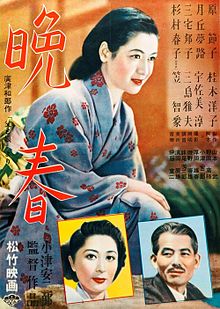| Late Spring | |||||
|---|---|---|---|---|---|
 Theatrical release poster | |||||
| Japanese name | |||||
| Kanji | 晩春 | ||||
| |||||
| Directed by | Yasujirō Ozu | ||||
| Screenplay by |
| ||||
| Based on | Father and Daughter by Kazuo Hirotsu | ||||
| Produced by | Takeshi Yamamoto | ||||
| Starring |
| ||||
| Cinematography | Yūharu Atsuta | ||||
| Edited by | Yoshiyasu Hamamura | ||||
| Music by | Senji Itō | ||||
Production company | |||||
| Distributed by | Shochiku | ||||
Release date | |||||
Running time | 108 minutes | ||||
| Country | Japan | ||||
| Language | Japanese | ||||
Late Spring (晩春, Banshun) is a 1949 Japanese drama film directed by Yasujirō Ozu and written by Ozu and Kogo Noda, based on the short novel Father and Daughter (Chichi to musume) by the 20th-century novelist and critic Kazuo Hirotsu. The film was written and shot during the Allied Powers' Occupation of Japan and was subject to the Occupation's official censorship requirements. Starring Chishū Ryū, who was featured in almost all of the director's films, and Setsuko Hara, marking her first of six appearances in Ozu's work, it is the first installment of Ozu’s so-called "Noriko trilogy", succeeded by Early Summer (Bakushu, 1951) and Tokyo Story (Tokyo Monogatari, 1953); in each of which Hara portrays a young woman named Noriko, though the three Norikos are distinct, unrelated characters, linked primarily by their status as single women in postwar Japan.[note 1]
Late Spring belongs to the type of Japanese cinema known as shomin-geki, a genre that deals with the ordinary daily lives of working class and middle class people of modern times. The film is frequently regarded as the first in the director's final creative period, "the major prototype of the [director's] 1950s and 1960s work".[3] These films are characterized by, among other traits, an exclusive focus on stories about families during Japan's immediate postwar era, a tendency towards very simple plots and the use of a generally static camera.[1][4]
Late Spring was released on September 19, 1949, to critical acclaim in the Japanese press. In the following year, it was awarded the prestigious Kinema Junpo critics' award as the best Japanese production released in 1949. In 1972, the film was commercially released in the United States, again to very positive reviews. Late Spring has been referred to as the director's "most perfect" work,[5] as "the definitive film of Ozu's master filmmaking approach and language"[6] and has been called "one of the most perfect, most complete, and most successful studies of character ever achieved in Japanese cinema".[1] In the 2012 version of Sight & Sound's decennial poll of "The Greatest Films of All Time", published by the British Film Institute (BFI), Late Spring appears as the second highest-ranking Japanese-language film on the list at number 15, behind Ozu's own Tokyo Story at number 3.
- ^ a b c Richie, p. 235
- ^ Bordwell, p. 307
- ^ Bordwell, p. 311
- ^ "Umbrella: Issue 2, Spring 2007 – Dan Schneider on Yasujirō Ozu's Late Spring". Retrieved July 19, 2011.
- ^ Russell, Catherine (2007). "Late Spring [DVD Review]". Cinéaste. Vol. 32, no. 2. p. 65. Retrieved February 7, 2012.
- ^ "Late Spring (1949) – Yasujirō Ozu (Ozu-san.com)". Retrieved September 4, 2011.
Cite error: There are <ref group=note> tags on this page, but the references will not show without a {{reflist|group=note}} template (see the help page).